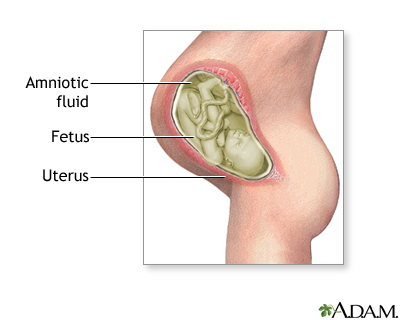 |
| Amniotic Fluid |
Amniotic fluid is a colorless liquid made of water, fetal skin cells, and fetal waste, and is contained within the amniotic sac or "bag of waters" that surrounds your baby. This buoyant fluid not only protects and cushions your baby, it helps your baby grow uniformly, helps bones and muscles develop, allows your baby to move within the uterus, and keeps the walls of the amniotic sac from sticking to your baby. Your baby also breathes this fluid in and out while still in the womb, helping his lungs to grow. By the end of your pregnancy, there is approximately one quart of amniotic fluid surrounding your baby.
For the first four months or so of your pregnancy, the placenta produces amniotic fluid; but after your baby's kidneys start to function, they take over amniotic fluid production for the remainder of the pregnancy. The fluid is constantly circulated as your baby "breathes" and swallows it and then excretes it as urine. However, amniotic fluid is not urine as we know it; the majority of your baby's waste is actually removed through the placenta and is then filtered by your kidneys.
An excessive amount of amniotic fluid is called polyhydramnios, and is often associated with a multiple pregnancy (twins or triplets), congenital anomalies, or gestational diabetes. An abnormally small amount of amniotic fluid is known as oligohydramnios, and may the result of a postdate pregnancy, ruptured membranes, placental dysfunction, or fetal abnormalities.
Many women believe that their water will break just before going into labor, signaling its onset; but this is usually not the case. In fact, only 10 percent of pregnant women's water breaks before their labor begins. Most women's water doesn't break until they are at the hospital in active labor. Indeed, it can occur anytime from the onset of labor to birth and sometimes the doctor must manually break the sac.
When your water breaks, you might notice anything from a slight dampness or small trickle of water, to a gush of fluid from your vagina. The fluid should be clear and non-odorous. If you suspect your water has broken, call your doctor and report the color, odor, quantity of fluid, and time of the break. If your water breaks or develops a small tear before your baby is ready to be born, it can cause serious complications. Premature Rupture of Membranes, or PROM, can cause infection, premature labor and birth. In some cases, however, the sac heals itself and the pregnancy can progress until full-term.
|
Respected Readers:
|

0 comments on "Amniotic Fluid"
Post a Comment